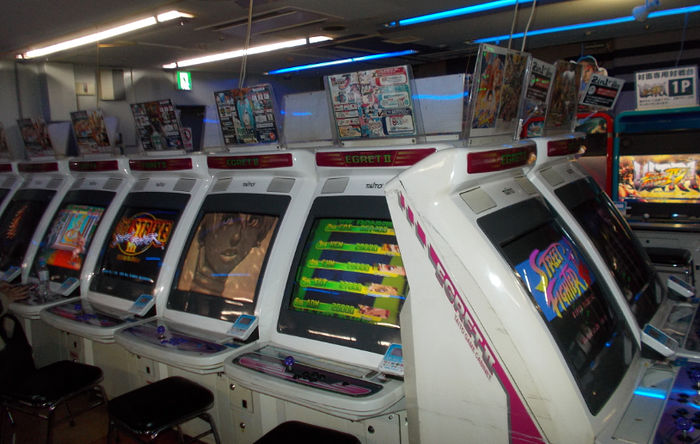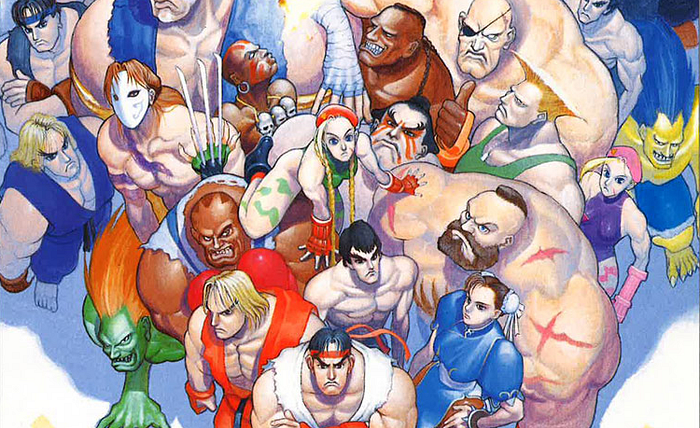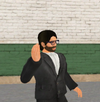The History of Street Fighter II
Looking back at over three decades of Capcom's seminal fighting franchise

Hadouken! It’s a word that all of us have heard at some point, a word which has since become synonymous with any fireball projectile attack, and one you’ll likely to hear it over and over any time you face Ryu in Street Fighter II.
The franchise may have officially started with the far less impactful 1987 debut, but it was in February 1991 when the series truly began with the release of Street Fighter II: The World Warrior. This game shaped not just the series’ identity for decades to come, but also forged the very format of 2D fighting games we know today. Despite having mechanically complex and visually stunning fighting games like Guilty Gear -Strive- on the horizon, Street Fighter II continues to be almost eternally playable, and maintains relevance in the fighting community enough to justify a brand-new sequel in 2017.
Street Fighter II is iconic for all the right reasons, from the music to the artistic presentation and all else in-between, everything about it still catches a player’s eye no matter what video game era they were born into. At this stage Street Fighter V dominates the fighting scene, but even in the presence of next-gen sequels, Street Fighter II still remains a seminal benchmark that any player can enjoy. The accessibility and hidden depth of Street Fighter II is something even Capcom has struggled to replicate with the many, many sequels and editions over the years.

As we approach its 30th anniversary, it’s amazing to see just how accessible and available Street Fighter II continues to be. Whether it is the 30th anniversary collection released in 2018, the plethora of ports on any console, or even the recent micro-sized My Arcade replication of the arcade cabinet, gamers don’t have to look very far to find some playable form of the game. Better yet, they don’t have to look too far to find a rival either.
Walk into any amusement center in Japan today, and Street Fighter II still maintains a strong presence. Even though the series peaked in its popularity during the early ‘90s, the experience of stepping into this world still feels just as special even today, almost religious in a way. There is something memorable about connecting with another player on one of the many arcade cabinets, engaging in a test of skill and timing like it was a playground match of rock, paper, scissors. The Netflix anime series High Score Girl captures the very essence of the Street Fighter II lifestyle perfectly.
To commemorate three decades of its continued relevance in the gaming landscape, it is worth taking a step back to appreciate just how far Street Fighter II has traveled in its evolution. Yes, we all like to joke about the many editions Capcom like to pump out, especially with the dubious DLC model of Street Fighter V, but back in the day each iteration of Street Fighter II was a substantial evolution. These games would pave the way for the likes of BlazBlue, The King of Fighters, and although its fan-base will never admit this, but even Mortal Kombat.
It all started in 1991, and despite sequels, prequels, spin-offs, and the like, the final chapter of Street Fighter II would be written in 2017. In the grand scheme of it all, this is truly an amazing legacy for any video game.
Street Fighter II: The World Warrior (1991)

Many will still swear by the claim of the original being the best, and while it may feel a bit dated from a balancing and gameplay standpoint (not to mention the many bugs discovered over the decades), the original World Warrior is a cultural artifact in the truest sense. Instantly recognizable characters with unmatched presentation for its time, this was the foundation of the Street Fighter franchise, and the many fighting games which followed after. There were many firsts here, one of which included the power of video game rumors and myths being able to take a life of their own, as false reports of secret fighters and the like would spread like wildfire.
While subsequent revisions would eventually perfect the formula, The World Warrior is still fondly remembered and preferred, especially by nostalgic players who prefer the sublime simplicity of it all. Sometimes less is more, and even now you will meet veteran gamers making unverified claims of being a Street Fighter II champion once.
Street Fighter II: Champion Edition (1992)

Where the original had its four boss characters locked and unplayable, Champion Edition would make these super charged bosses playable for the first time, along with some tweaks and enhancements to the gameplay. Long before players had to fork out for season passes, fighting game revisions would be packaged and presented as a fully-fleshed sequel. Back then it didn’t feel like Capcom were cash grabbing with incremental revisions, as Champion Edition absolutely lived up to its namesake. It would also introduce the still confusing naming convention of the three bosses: M. Bison, Balrog, and Vega. Which one is which? Well, it depends on where in the world you play Street Fighter. Just make sure you don’t tell Iron Mike Tyson about it.
The most notable home conversion of Champion Edition was for the SEGA Mega Drive, and even now it remains an important piece in the console’s history as one of its most popular games. It was included as one of the titles in the Sega Mega Drive Mini.
Street Fighter II Turbo: Hyper Fighting (1992)

Mere months after the launch of Champion Edition, Capcom would strike the proverbial gold when they launched Hyper Fighting to absolute critical acclaim worldwide. The key difference in this release? Speed. As an arcade game Street Fighter II was already a fast-paced experience with great replay value for players, but adding that extra Turbo really did wonders for the flow of battles, which made players come back for more. The extra speed allowed the tide of battle to be more unpredictable, and it made the case of “one more match” all the more appealing.
Although Street Fighter II had found a home on consoles before, it was the SNES version of Turbo: Hyper Fighting which instantly became one of the most successful SNES releases of all time, and was rightfully included in the carefully curated lineup for the SNES Classic Mini. Most nostalgic gamers recall the SNES release of Turbo: Hyper Fighting as a magical time, and a couple of decades later Capcom would attempt to recreate this magic once more on Nintendo Switch.
Super Street Fighter II: The New Challengers (1993)

We all roll our eyes these days whenever a seasonal character pack gets announced for Street Fighter V, but back in 1993 the idea of new challengers joining the already popular Street Fighter II roster was just so novel and exciting. It was more than just new faces to freshen up an already cool roster, as over the course of just three years the graphics, sound, gameplay of Street Fighter II had been spiced up substantially over the 1991 original. The improvements were so significant that Capcom could have easily gotten away with calling it Street Fighter III if they wanted. Of course, that particular sequel would eventuate in due course.
One of the most memorable aspects of the experience, before even getting into the character select screen, was the game’s intro sequence. Meticulously crafted and animated pixel for pixel, it was a technical marvel to see such a detailed sprite model of Ryu charge up a vicious Hadouken. It’s definitely still up there as one of the coolest animated intros in any game.
Super Street Fighter II Turbo (1994)

By the time Super Street Fighter II Turbo landed in 1994, Capcom had basically perfected and completed Street Fighter II. For the longest time this was basically the final chapter, and it remained in regular rotation on consoles, and in the competitive fighting scene, for decades to follow. As the Turbo in the title indicates, this was perhaps the fastest iteration of Street Fighter II ever, and it also lived up to its Super moniker by introducing Super Combos for the very first time. These powerful moves were designed to shift the tide of battle, especially to allow weaker players to shift the momentum to their favor with a Hail Mary maneuver. The game also started the tradition of super-secret boss battles, as this was also where the mythology of Akuma began. Now among the most popular characters today, back then his presence had an awe-inspiring vibe about it.
In Japan, the game had the very lengthy but cool subtitle of Super Street Fighter II X: The Grand Master Challenge. Fitting too, as this was Street Fighter II firing on all cylinders and then some. For the longest time this was considered to be the be all end all for Street Fighter II, as aside from ports and remasters (the most notable being the Dreamcast port which featured online multiplayer for the first time), Capcom had moved on with games like Street Fighter Alpha, Street Fighter III, and so on. Yet after over two decades, and to celebrate the first year of the Nintendo Switch, Capcom’s seminal fighter stepped out of retirement with a new coat of paint.
Hyper Street Fighter II: The Anniversary Edition (2003)

Not quite a new edition or sequel, as this release was more of a compendium and celebration of all things Street Fighter II. Launching on PlayStation 2 first back in 2003, Hyper Street Fighter II: The Anniversary Edition essentially fused all prior versions of the game into one mega crossover. Fans had access to all character versions here as they could, for example, pit the Champion Edition version of Ryu against the Super Turbo version. This was an anniversary celebration with no attention paid to balancing for competitive play. Surprisingly, older versions of a character were significantly stronger than their more revised counterparts. In other words, you didn't want to mess with World Warrior versions of Sagat and Barlog.
Although initially intended as a home console exclusive, player demand soon resulted in an arcade cabinet version, which has since remained a staple of Japanese amusement centers all over the country. Hyper Street Fighter II recently saw a release on modern platforms thanks to Capcom Fighting Collection (2022) and Capcom Arcade 2nd Stadium (2022), with the former offering online multiplayer.
Ultra Street Fighter II: The Final Challengers (2017)

Over two decades after the supposed end of this classic series, Street Fighter II returned as part of Nintendo Switch’s impressive first year lineup in 2017. The intention behind this revival was simple: to recreate the same magic Street Fighter II Turbo did on the SNES. It was a sincere nostalgic sentiment for sure, and yet critics didn’t take too kindly to the price tag of Ultra Street Fighter II at launch, nor were they impressed by the rather silly Way of the Hadou mode. Still, having three new playable characters was a huge deal, especially considering how the balancing of the roster had already been fine tuned to perfection back in 1994. Granted these were variations of existing fighters, but the unique play styles of Evil Ryu, Shin Akuma, and especially Violent Ken, each offered a novel play style to the classic Street Fighter II gameplay.
Despite a lukewarm critical reception, the intended audience fell in love with Ultra Street Fighter II almost immediately and have held on tight ever since. The sales exceeded Capcom’s expectations, and even now the game’s online lobbies are full of players always willing to throw another Hadouken. The player base is dedicated, with many of them having clocked over 2,000 hours on the game according to their Switch player profile. Game critics may have moved on, but the heart and soul of Street Fighter II still resonates with diehard gamers the same way it did back in 1991.
Capcom will probably never create another sequel (Ultra Super Duper Street Fighter II: Challengers Recharged Edition maybe?), but this is a series gamers all over simply cannot get enough of. Whether it is nostalgic gamers latching on to the past, or new players discovering the very essence of fighting games for the first time, it is likely Street Fighter II will continue to be played and celebrated for many more decades to come, bringing gamers from all corners of the globe together as World Warriors.

Special thanks to The Fighters Generation for their impressive archives and galleries.
